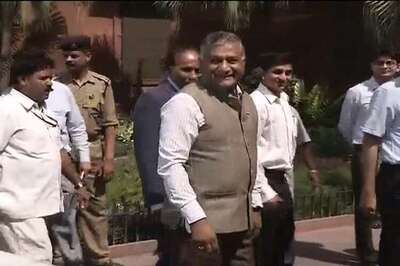
views
New Delhi: A day before Finance Minister Nirmala Sitharaman presents her maiden Budget on 5 July, the Economic Survey for the year 2019 was tabled in both houses of the Parliament on Thursday. The Economic Survey is an annual document that reviews the developments in the economy over the previous 12 months.
The document will be tabled by Chief Economic Adviser Krishnamurthy Subramanian. "Looking forward with excitement to table my first - and the new Government's first - Economic Survey in Parliament on Thursday. #EcoSurvey2019" he tweeted.
The Economic Survey summarises the performance on major development programmes, highlights the policy initiatives of the government and analyses the prospects of the economy in the short to medium-term. Every year, the Economic Survey is tabled in the Parliament a day before the Union Budget.
Since 2015, the survey document essentially consists of two parts. One part consists of commentary on the state of the economy, which is released before the Union Budget. The other part carries key economic statistics and data, which is tabled in July or August. This split in the presentation took effect after the Union Budget was moved from the last working day of February to the first day of the month in 2017.
The flagship document is prepared by the Department of Economic Affairs, which comes under the Finance Ministry, and released under the guidance of the Chief Economic Advisor (CEA).
The Economic Survey serves as a useful policy document since it also contains policy ideas, key statistics on economic parameters and in-depth research on macro and sectoral trends. Often, the survey serves as a policy guideline for the Union Budget. However, its recommendations are not binding on the government. More often than not, the policy recommendations presented in the document have not made their way into the Budget proposals.
However, the government considers the document “useful for policymakers, economists, policy analysts, business practitioners, government agencies, students, researchers, the media, and all those interested in the development in the Indian economy”.
Highlights of previous Economic Surveys under Modi govt:
The Narendra Modi government presented the Economic Survey in 2015, 2016, 2017, and 2018.
The 2015 survey was reportedly inspired by the International Monetary Fund's (IMF) World Economic Outlook. The survey basically focused on JAM – Jan Dhan, Aadhaar and Mobile.
The next Economic Survey (2016) focused on creating a more competitive environment and highlighted the “Chakravyuha challenge”, a Mahabharata-inspired term to denote the lack of exit policy for companies running in losses. The survey noted that the lack of exit policy has been an impediment to investment, efficiency, job creation, and growth. The survey also talked about major investments in human resources to reap the demographic dividend.
The 2017 Economic Survey deliberated on the demonetisation policy. While claiming that demonetisation was a complex idea, the document noted that the policy had short-term costs but potentially long-term benefits. The survey also introduced the idea of ensuring Universal Basic Income (UBI) for every citizen. Volume two of the document said that there remained both anxiety and optimism in the economy due to various factors.
The Economic Survey 2018 had a bright pink cover in order to “send the message of empowerment of women and gender equality”. The survey also touched upon the cultural obsession with having a male child and focused on parameters determining women empowerment in India.




















Comments
0 comment